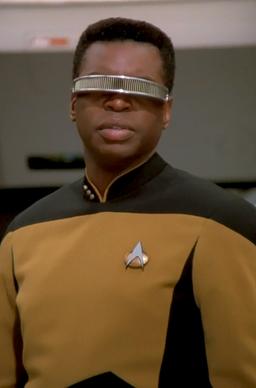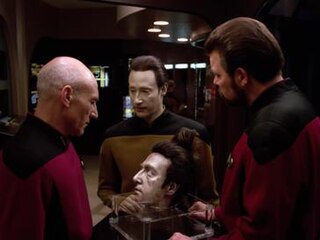
Chakotay is a fictional character who appears in each of the seven seasons of the American science fiction television series Star Trek: Voyager. Portrayed by Robert Beltran, he was First Officer aboard the Starfleet starship USS Voyager, and later promoted to Captain in command of the USS Protostar in Star Trek: Prodigy. The character was suggested at an early stage of the development of the series. He is the first Native American main character in the Star Trek franchise. This was a deliberate move by the producers of the series, who sought to provide an inspiration as with Uhura in Star Trek: The Original Series for African Americans. To develop the character, the producers sought the assistance of Jamake Highwater who falsely claimed to be Native American. Despite first being named as a Sioux, and later a Hopi, Chakotay was given no tribal affiliation at the start of the series, something that was later resolved in the episode "Tattoo".

Star Trek: The Animated Series (TAS) is an American animated science fiction television series created by Gene Roddenberry. It originally aired simply under the title Star Trek, subtitled Created by Gene Roddenberry, on Saturday mornings from September 8, 1973, to October 12, 1974, on NBC, spanning 22 episodes over two seasons. The second series in the Star Trek franchise, it features mostly the same characters as Star Trek: The Original Series. Set in the 23rd century, the series follows the further adventures of the Starship USS Enterprise as it explores the galaxy.

Geordi La Forge is a fictional character who appeared in all seven seasons of the American science fiction television series Star Trek: The Next Generation and its four feature films as well as the third season of Star Trek: Picard. Portrayed by LeVar Burton, he served as helmsman of the USS Enterprise-D in the first season, then occupied the role of the chief engineer for the rest of the series and in the films. La Forge has been blind since his birth and uses technological devices that allow him to see – a VISOR in the series and the first film, replaced by ocular prosthetic implants in the last three films and in the Star Trek Picard TV Series.

In the fictional universe of Star Trek the United Federation of Planets (UFP) is the interstellar government with which, as part of its space force Starfleet, most of the characters and starships of the franchise are affiliated. Commonly referred to as "the Federation", it was introduced in the original Star Trek television series. The survival, success, and growth of the Federation and its principles of freedom have become some of the Star Trek franchise's central themes.

Natasha "Tasha" Yar is a fictional character that mainly appeared in the first season of the American science fiction television series Star Trek: The Next Generation. Portrayed by Denise Crosby, Yar is chief of security aboard the Starfleet starship USS Enterprise-D and carries the rank of lieutenant. The character's concept was based upon the character of Vasquez from the film Aliens (1986). Following further development, she became known first as Tanya, and then Tasha. Crosby had auditioned for the role of Deanna Troi, while Rosalind Chao became a favorite for Tasha. After Marina Sirtis auditioned for the role, the series' creator Gene Roddenberry decided to switch the roles for the actresses, with Sirtis becoming Troi and Crosby becoming Yar. Chao would later appear on the series in a recurring role as Keiko O'Brien.

Dr. Katherine Pulaski is a fictional medical doctor in the American science fiction television series Star Trek: The Next Generation. She served a rotation as the chief medical officer aboard the Federation starship USS Enterprise-D. During her time on the ship, her medical skills saved the lives of both Captain Jean-Luc Picard and Commander William Riker. She inadvertently caused Geordi LaForge to create a hologram of Professor Moriarty that became self-aware, after a bet involving the abilities of Lt. Commander Data. Pulaski seemed averse to most new technology and preferred to avoid the transporter, but was forced to rely on it to save her own life from a genetically-modified infection. Before arriving on the Enterprise-D, she previously served on the USS Repulse. For a time in her past, she was romantically involved with William Riker's father, Kyle Riker, with whom she has maintained a friendship.

David Gerrold is an American science fiction screenwriter and novelist. He wrote the script for the original Star Trek episode "The Trouble with Tribbles", created the Sleestak race on the TV series Land of the Lost, and wrote the novelette "The Martian Child", which won both Hugo and Nebula Awards, and was adapted into a 2007 film starring John Cusack.

"The Neutral Zone" is the season finale of the first season of the American science fiction television series Star Trek: The Next Generation, originally aired within the United States on May 16, 1988, in broadcast syndication. The episode originated as a story submission purchased by Paramount written by Deborah McIntyre and Mona Clee, and was turned into a teleplay by Maurice Hurley. Because of the 1988 Writers Guild of America strike, Hurley created the script in a day and a half, and the timescale forced the abandonment of both the idea of a two-part episode and of the first appearance of the Borg, which was delayed until the following season episode "Q Who".
"Datalore" is the thirteenth episode of the first season of the American science fiction television series Star Trek: The Next Generation, originally aired on January 18, 1988, in broadcast syndication. The story was created by Robert Lewin and Maurice Hurley, and turned into a script by Lewin and the creator of the show, Gene Roddenberry. It was Roddenberry's final script credit on a Star Trek series. The director was originally to be Joseph L. Scanlan, but following delays in pre-production caused by script re-writes, it was reassigned to Rob Bowman.
U.S. television science fiction is a popular genre of television in the United States that has produced many of the best-known and most popular science fiction shows in the world. Most famous of all, and one of the most influential science-fiction series in history, is the iconic Star Trek and its various spin-off shows, which comprise the Star Trek franchise. Other hugely influential programs have included the 1960s anthology series The Twilight Zone, the internationally successful The X-Files, and a wide variety of television movies and continuing series for more than half a century.
"Justice" is the eighth episode of the first season of the American science fiction television series Star Trek: The Next Generation. The episode first aired in broadcast syndication on November 9, 1987. Directed by James L. Conway, writer John D. F. Black originally pitched the story, but after Worley Thorne and Gene Roddenberry modified it, Thorne wrote the script. Because of the changes to the story, Black chose to receive his credit under the pseudonym Ralph Wills.
"The Quality of Life" is the 135th episode of the American science fiction television series Star Trek: The Next Generation. It is the ninth episode of the sixth season.

"Time’s Arrow" is the 26th episode of the fifth season and the first episode of the sixth season of the American science fiction television series Star Trek: The Next Generation, it comprises the 126th and 127th episodes overall. A two-part episode of Star Trek: TNG, the first episode was a cliffhanger season finale for the fifth season and the second episode was the premiere for the sixth season.

First contact is a common science fiction theme about the first meeting between humans and extraterrestrial life, or of any sentient species' first encounter with another one, given they are from different planets or natural satellites. The theme allows writers to explore such topics such as xenophobia, transcendentalism, and basic linguistics by adapting the anthropological topic of first contact to extraterrestrial cultures.
"Half a Life" is the 22nd episode of the fourth season of the American science fiction television series Star Trek: The Next Generation, the 96th episode overall. It was originally released on May 6, 1991, in broadcast syndication. The episode was the first of the series written by Peter Allan Fields, who later joined the writing staff. Director Les Landau said that "Half a Life" was a morality play about "how society deals with the elderly".
The planetary systems of stars other than the Sun and the Solar System are a staple element in many works of the science fiction genre.
Star Trek is an American science fiction media franchise created by Gene Roddenberry, which began with the eponymous 1960s television series and became a worldwide pop-culture phenomenon. The franchise has expanded into various films, television series, video games, novels, and comic books, becoming one of the most recognizable and highest-grossing media franchises of all time.
Thomas Eugene DeWeese was an American writer of science fiction, best known for his Star Trek novels. He also wrote Gothic, mystery, and young adult fiction, totalling more than 40 books in his career. He published as Gene DeWeese and Jean DeWeese; his pseudonyms as a collaborator included Thomas Stratton and Victoria Thomas.

The Klingons are a fictional species in the science fiction franchise Star Trek.
The following outline is provided as an overview of and topical guide to Star Trek:











